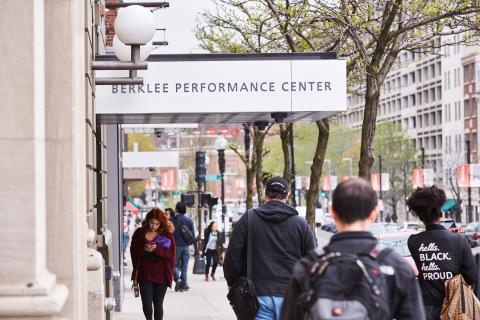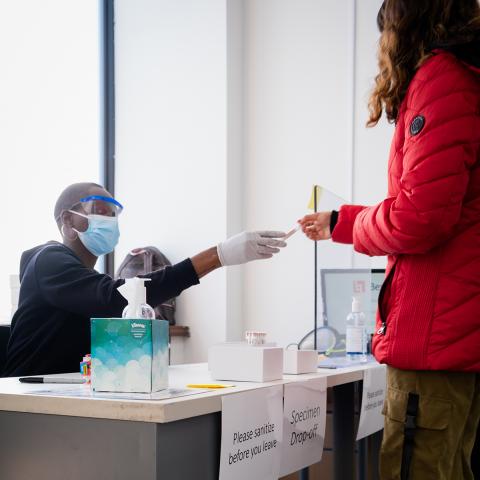CFO Optimistic About Berklee's Future

Image by Kelly Davidson
For Berklee, 2020 was supposed to be a year of celebration, with the college’s 75th anniversary, a new campus in New York City, and the introduction of its first woman president. While the past year did include these exciting milestones, they took place amidst an extraordinary moment in history, one that forced Berklee to reinvent how we work, teach, learn, perform, and create.
When the pandemic hit last year, President Roger H. Brown urged Berklee to come together and do what it does best: “improvise and innovate.” A Boston Conservatory at Berklee student rallied more than 70 of her peers to form a virtual orchestra whose viral video inspired millions of people around the world. The institution pivoted to remote learning, tapping into Berklee Online’s near two decades of expertise to create a virtual experience worthy of students’ talent and time. And when students and faculty began returning to campus in January, Berklee continued to prioritize safety by expanding health care support, reconfiguring spaces to optimize social distancing, and launching a testing protocol that is among the most rigorous in higher education.
To ease the financial burden on students, Berklee took a number of critical steps, including freezing tuition for this academic year, waiving comprehensive fees for the fall 2020 semester, and substantially increasing scholarship support, including the issuance of $2,500 grants to all students who enrolled last fall. All of these actions, along with the establishment of emergency aid funding and a robust COVID-19 health and safety infrastructure, posed daunting financial challenges.
While the institution is likely to post an operating loss this year, Berklee’s financial strength coming into the pandemic has helped it to absorb that loss as it prepares for what is expected to be another difficult fiscal year. But despite these challenges, Richard Hisey, Berklee’s senior vice president for Administration and Finance, chief financial officer, and chief investment officer, says that Berklee’s overall financial outlook is healthy. We talked to Hisey about the pandemic’s impact on the budget, and Berklee’s fiscal prospects in the short and long term; below are lightly edited excerpts from the conversation.

Richard Hisey, senior vice president for Administration and Finance
What were the most substantial challenges we faced in the past year? What actions did Berklee take to address those challenges?
The number-one challenge and number-one priority of the past year was supporting the health and safety of the Berklee community. To address this, we set up a dedicated committee to, one, vacate our campus with the onset of the pandemic, support our transition to virtual learning, and immediately issue credits and refunds to our students for unused room and board and comprehensive fees; two, design a COVID-19 safety infrastructure utilizing industry best practices; and three, plan for the reopening of our campus with appropriate modifications to our physical spaces, including the implementation of best-practice protocols, the introduction of an on-site testing center run by Tufts Medical Center with support from the Broad Institute, and the introduction of new integrated technologies to support a safe campus. Our staff and faculty have worked tirelessly and closely together to support the health and safety of our community and the optimization of our learning environments to maintain the continuation of our students’ academic progress.
"All of the tough decisions and hard work of the past year will support our continuing financial strength, the health and safety of our community, and the high quality of the Berklee educational experience."
—Richard Hisey
How seriously has the coronavirus affected our budget? Are there numbers you can share that illustrate that impact?
COVID-19 and all of the actions we have taken in response to the pandemic produced the largest financial challenge that Berklee has ever faced. In total, we faced a financial shortfall of over $70 million, which is over 20 percent of our budget. Thanks to the tireless efforts of our community, we have successfully offset over 75 percent of that shortfall. We were able to do this through reductions across all expense categories. Unfortunately, given that faculty and staff salaries are our largest cost, this also necessitated the introduction of mandatory staff furloughs, which has had an undeniable impact on our community.
How would you describe Berklee’s financial outlook, currently and into next year?
As noted, we expect to record an operating loss for the year, but have the financial strength to absorb that loss. I would also note that Berklee Online has experienced very strong growth in this environment, providing thousands of students with a high-quality online experience. Berklee Online’s success has been both strategic and financial, helping to lower the loss we anticipate for this year.

Berklee's COVID-19 Testing Center
Looking forward, we fully expect the pandemic to continue to impact us financially into next fiscal year (starting on June 1) and are planning accordingly. We are very encouraged by recent news of accelerated vaccine distribution, but nevertheless anticipate some continuing impacts on enrollment and the need to maintain our COVID-19 infrastructure for some period of time to support the health of our community. So, while we are all very excited about having all of our students back for the on-campus experience, we do expect some continuing impacts from the pandemic in our next fiscal year. We also anticipate that Berklee Online’s success, both strategic and financial, will continue into the coming year.
Longer term, we feel that all of the tough decisions and hard work of the past year will support our continuing financial strength, the health and safety of our community, and the high quality of the Berklee educational experience.
What factors do you consider in terms of short- and long-term financial planning?
Aside from the health and safety of our community, the most important factors in our short- and long-term financial planning are Berklee’s strategic priorities. These include investments in financial aid for our students; investments in facilities such as the newly opened practice room complex on Boylston Street; new educational programs and offerings; other student services (career planning, etc.); and the like. Everything we do financially is driven by the strategic priorities of the institution.
Are there any additional federal funds that have become available for high-need students?
As part of the CARES Act last summer and again this fall, our students have received extra funding and support, which is in addition to the increases in student aid that Berklee has prioritized over the years, including this past year. We anticipate that the new stimulus bill, if passed, will provide additional support.
What is the enrollment outlook for fall 2021?
We are seeing very strong interest in our fall semester as we head towards our regular action decision date of March 31. Our early action decision pool was the largest it’s ever been, and the quality within that pool is exceptional. Similar to all of higher education, we are paying close attention to the external factors that could impact our international applicants and admits.
